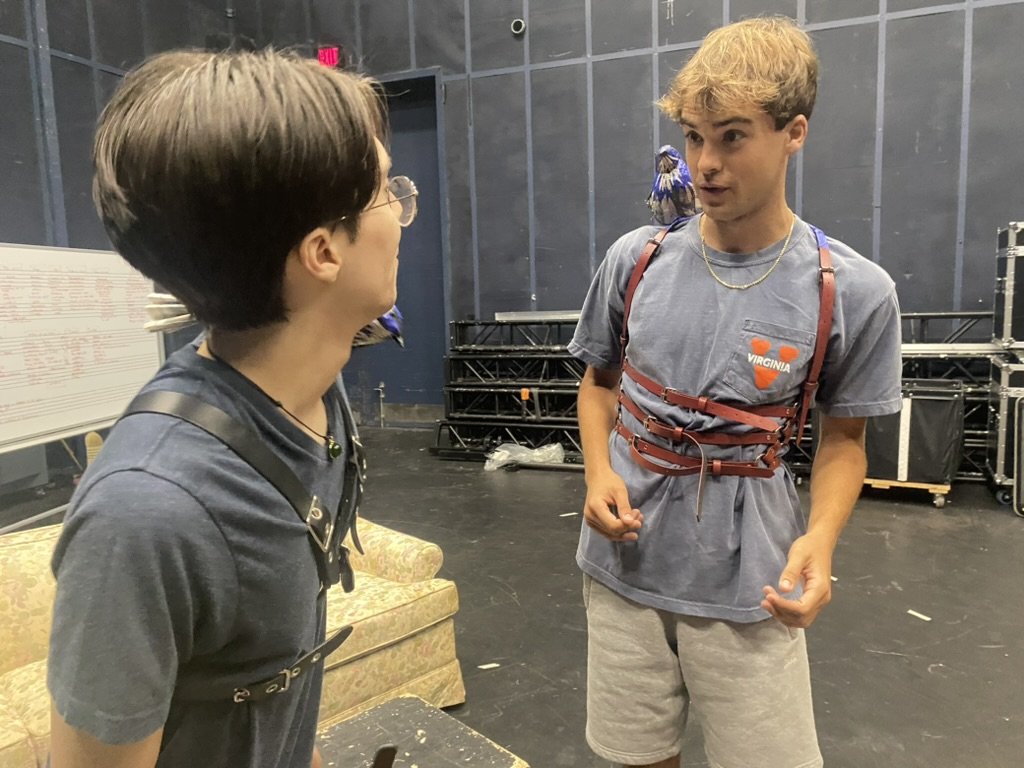Plastic Nest
by Tracy Held
workshop directed by Lane Michael Stanley
ColLABo at Carnegie Mellon University
May 27-June 9, 2024
About the Play
After moving into their first house together, a married couple grapples with renovating the home while grieving a parent. Meanwhile, a pair of nesting scrub jays outside their window struggles to care for their chicks in a neighborhood littered with trash.
This play explores longterm relationships, grief, and environmental pollution.
ColLABo at Carnegie Mellon
CMU’s ColLABo is a two-week residency focused on workshopping production design questions rather than a script. For Plastic Nest, this dedicated collaboration time was crucial to be able to explore design approaches with a director, scenic designer, movement specialist, costume designer, puppet specialist, actors, and the playwright in an exploratory process.
Key Points of Exploration
Plastic Nest is largely written in realism, with the story driven by naturalistic dialogue, character, and relationships, however, it also features two talking birds, which adds elements of surrealism. Our mission question was: how can we find an approach to the birds and the scenic design that highlights the interspecies relationship, including the scale relationship (where the human species is many times larger than the bird species), while allowing performance and text (rather than spectacle) to carry the scenes forward?
The open-ended format of the residency allowed/required our team to make key decisions as a group. For example, scenic design scale and bird character scale questions were not defined by either the playwright or the director, or even determined before rehearsal to give parameters for a movement director or puppetry consultant to work within. Instead, these questions became negotiations between the entire team as each department highlighted the pros and cons of their specialized interest.
Scenic rendering by Dahlia Al-Habieli.
Scenic Design: Where Do Things Go and What Size Are They?
In exploring this story, we identified three key scenic locations that were heavily defined by which character species were present. Our scenic designer, Dahlia Al-Habieli, was determined to create a dynamic stage layout that allowed overlap between the indoor human livingroom and the outdoor bird nest. Eliminating a more simple, fixed layout setting the outdoor bird nest next to the human house allowed us to add metaphoric layers of meaning between the human and bird couples and between the physical impact of the humans’ trash and the birds’ habitat.
Costume rendering by Sophie Schneider.
Bird Design: What Do the Birds Look Like and How Do They Move?
We discovered a hybrid approach to the birds that utilized both movement and hand props.
When a bird was talking to a human, we used hand puppets to highlight the interspecies relationship. The performer was still fully visible, and often mirrored the movement of the puppet (for example, both might tilt their head in curiosity at the same time).
When the birds were talking to each other, these puppets moved to their shoulders, and the performers expressed the birds with their full bodies and some subtle bird movement language, such as bent knees, head tilts, and small hops, in their “zoomed-in” nest.
What’s Next?
We are now seeking the right theater for this intimate piece exploring relationships, environmentalism, grief, and the things we need to clear away. If interested, please contact Lane.
ColLABo Team
Playwright: Tracy Held
Director: Lane Michael Stanley
Co-Director & Movement Director: Sarah Jack
Scenic Design: Dahlia Al-Habieli
Costume Design: Sophie Schneider
Puppetry Consultant: Jamie Agnello
Performers: Trey Caperton, Lilac Emery-Haynes, Marco Porras, Aidan Winn



